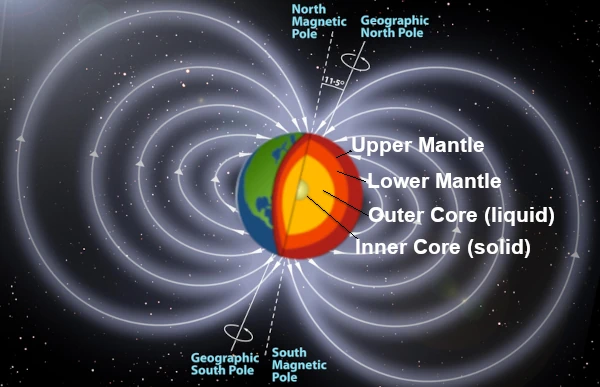
Image description: Terrestrial magnetism results mainly from the movement of molten metal in the Earth's outer core, which generates a global magnetic field. This field is complex, oscillating between relative stability and polarity inversions, a phenomenon where the north and south magnetic poles swap positions. Source: astronoo.com
The Earth's Magnetic Field is generated by a mechanism called the "geomagnetic dynamo" occurring in the liquid outer core, composed of iron and nickel. The Earth's magnetic field can be roughly represented as that of a magnetic dipole, with a north pole and a south pole, forming the magnetosphere, a protective bubble around the planet.
The intense heat from the solid inner core (at about 6,000 K) generates a heat flux that causes thermal convection movements in the liquid outer core. It is the temperature difference between the inner and outer core that drives these convection movements. Hotter liquid metals rise while cooled elements sink, creating convection cells. This process occurs like in a pot of water on a heating plate, where the heat from the bottom of the pot creates convection currents in the water: heated water near the bottom rises to the surface while cooler water descends.
Due to the Coriolis effect from the Earth's rotation around its axis, the convection cells follow helical trajectories. Thanks to the influence of Earth's rotation, chaotic and turbulent movements follow certain major lines. The Coriolis force tends to align these convection movements into columns parallel to the Earth's axis of rotation. This alignment promotes a global organization of currents that allows a collective alignment of the magnetic field preferentially oriented along the Earth's rotation axis. This helps align and stabilize the magnetic field along an approximately north-south axis.
Furthermore, the movements of the liquid metal, which is conductive, generate electric currents that, in turn, create a magnetic field. This link between the movement of magnetic fields and the generation of electric currents creates what is known as electromagnetic induction. This positive feedback phenomenon amplifies the field until it reaches a stable (though fluctuating) configuration that constitutes the Earth's magnetic field.
Iron-containing minerals in volcanic and sedimentary rocks preserve the orientation of the Earth's magnetic field at the time of their formation, serving as paleomagnetic markers. By analyzing these rocks, geophysicists have been able to reconstruct a timeline of inversions, known as the magnetic chronology. These records show that the frequency of inversions varies widely over geological ages.
• The last magnetic polarity inversion, known as Brunhes-Matuyama, occurred about 780,000 years ago, marking the transition to the current normal polarity.
• The Olduvai inversion occurred about 1.8 million years ago.
• The Matuyama-Gauss inversion occurred about 2.58 million years ago.
• The Gauss-Gilbert inversion occurred about 3.6 million years ago.
• During the Cretaceous, polarity remained constant for about 40 million years (83 to 125 million years). This exceptional period of magnetic stability is called the "Cretaceous Normal Superchron".
• Another superchron, the Kiaman Superchron (Carboniferous - Permian, about 262 to 318 million years ago), but with an inverse polarity that remained constant for about 56 million years.